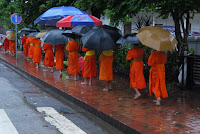Tak Bat (alms giving ceremony): Daily ritual in which Buddhist monks walk around collecting food from locals. Food collected that day is serves as their meals that day. The main food given is the ubiquitous sticky rice. Some hotels/guesthouses arrange for you to participate, but sometimes the quality of rice or food they give you may not be the best. Also, please note, this is a sacred religious ritual, please respect it and those participating in it. It is not a tourist attraction, so please refrain from talking loud, disturbing the monks with too many pictures, or blocking the pathway.



Morning Market: Located near the Luang Prabang National museum, it is an open air market where local farmers and food vendors sell produce, noodles, fresh seafood, meat, local crafts, and drinks.



In the market, I stumbled upon this noodle shop that served the famous Khao Soi which I had tried the day before. It was a nice mom and pop shop and was my kind of restaurant. This turned out to be one of the best decisions I made! The broth was so rich and hearty and the noodles were cooked just right. I don't know the name of the place, but it was only one of 2 or 3 noodle shops there.
Noodle shop in Morning Market:




Luang Prabang National Museum/Royal Palace- Consists of the former Royal Palace built in 1904, theatre, and Haw Pha Bang temple. The perimeter of the area is surrounded by simple white washed walls. It is the main draw in the main downtown area as the Morning and Night Markets are held. No photos or videos; and no shoes are allowed inside the palace. You can buy a ticket at ticket kiosk just inside the main gate entrance on the left side. Inside the palace, the main throne room showcased the wealth and opulence of the royal family with golden walls embedded with jewels, imported furniture and clothing, modern equipment, and gifts from other nations.




Wat Pahouak- Built in 1860, it is a small temple across from the Luang Prabang National Museum near the entrance to Mt. Phou Si. It can be accessed by stairs. It's exterior is a simple wooden structure that seems weathered and aged. Both times I visited it, there was no one else. Upon entering it, one can see 3 golden buddha statues with colorful frescos that have lasted decades. Considering it's age, it seems pretty well preserved and not obstructed by modern restorations or retouching. Even though it seemed abandoned and unimpressive from the outside, I thought it was a hidden gem due to its preserved state and isolated location. Besides Wat Xieng Thong, it was one of my favorite temples in Luang Prabang due to it's simplicity and unrestored state.



Mt. Phou Si and Wat Tham Phousi - Continuing up the mountain from Wat Pahouak, you will reach Mt. Phou Si. There is a small fee to enter. There are 355 steps that zigzag up the mountain so make sure you are up for it. It was so humid so it added to the discomfort. If you make it to the top you can see a simple temple with a gilded stupa. Mostly local worshippers visit the top to pray. There are stunning views from the top of the Mekong River and the town below.



Elephant Sanctuary Visit- I've always wanted to ride an elephant, but I hadn't had the opportunity before in my other travels. I made it a point to make sure that I took the opportunity this time. I booked a tour through my guesthouse with a tour of the elephant sanctuary and to the Kuang Si Waterfalls. I was picked up and taken to the elephant sanctuary which feeds, bathes, and cares for the few elephants. I learned that before elephants abundantly flourished centuries ago. But, poaching and natural disasters have diminished their number and many have fled to live in the jungle. Recently, many elephant sanctuaries were established to educate and repopulate the elephants.
At the sanctuary, we learned about the conservation work they were doing and background on elephant history in Laos. Then we were able to feed the elephants which was quite fun. Elephants eat several tons of food a day so they have to be constantly fed. The sanctuary grows bamboo and other plants to provide nutrients to the elephants. After, I rode an elephant along with one of the caretakers. It was an interesting experience. I never imagined I would ride an elephant. We toured the sanctuary during our route. It was nice and peaceful during the ride. I wish the ride was longer than the 20 minutes.
Elephant Sanctuary:






Kuang Si Waterfalls - After the elephant sanctuary, I visited the famous Kuang Si Waterfalls. It was pouring when I arrived and continued to rain during my visit there so it wasn't as enjoyable. It was smaller than I had imagined it to be. There also was a lot of tourists so it was a big crowded.


Thanks for reading and subscribing!
Instagram: joelglobetrotter




























